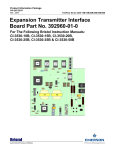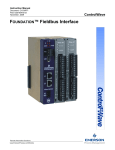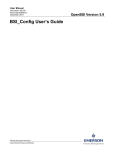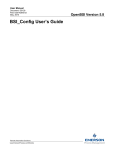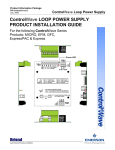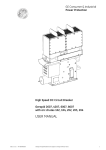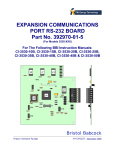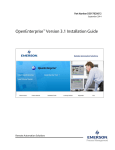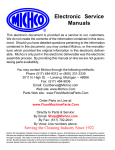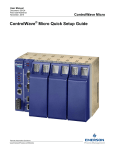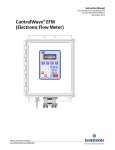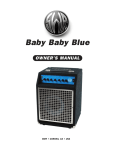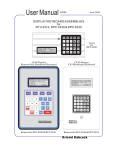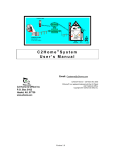Download PIP-EXPI/OTF - Low power I/O Expansion Board Part Number
Transcript
Product Information Package PIP-EXP I/O TF February, 2008 Low Power I/O Expansion Board Low Power I/O Expansion Board Part No. 392927-XX-X (For TeleFlow Plus, TeleRTU Plus, TeleRTU Module & TeleRecorder) For the following Instruction Manuals: CI-3530-20B, CI-3530-25B, CI-3530-35B & CI-3530-55B Remote Automation Solutions www.EmersonProcess.com/Remote IMPORTANT! READ INSTRUCTIONS BEFORE STARTING! Be sure that these instructions are carefully read and understood before any operation is attempted. Improper use of this device in some applications may result in damage or injury. The user is urged to keep this book filed in a convenient location for future reference. These instructions may not cover all details or variations in equipment or cover every possible situation to be met in connection with installation, operation or maintenance. Should problems arise that are not covered sufficiently in the text, the purchaser is advised to contact Emerson Process Management, Remote Automation Solutions division (RAS) for further information. EQUIPMENT APPLICATION WARNING The customer should note that a failure of this instrument or system, for whatever reason, may leave an operating process without protection. Depending upon the application, this could result in possible damage to property or injury to persons. It is suggested that the purchaser review the need for additional backup equipment or provide alternate means of protection such as alarm devices, output limiting, fail-safe valves, relief valves, emergency shutoffs, emergency switches, etc. If additional information is required, the purchaser is advised to contact RAS. RETURNED EQUIPMENT WARNING When returning any equipment to RAS for repairs or evaluation, please note the following: The party sending such materials is responsible to ensure that the materials returned to RAS are clean to safe levels, as such levels are defined and/or determined by applicable federal, state and/or local law regulations or codes. Such party agrees to indemnify RAS and save RAS harmless from any liability or damage which RAS may incur or suffer due to such party's failure to so act. ELECTRICAL GROUNDING Metal enclosures and exposed metal parts of electrical instruments must be grounded in accordance with OSHA rules and regulations pertaining to "Design Safety Standards for Electrical Systems," 29 CFR, Part 1910, Subpart S, dated: April 16, 1981 (OSHA rulings are in agreement with the National Electrical Code). The grounding requirement is also applicable to mechanical or pneumatic instruments that include electrically operated devices such as lights, switches, relays, alarms, or chart drives. EQUIPMENT DAMAGE FROM ELECTROSTATIC DISCHARGE VOLTAGE This product contains sensitive electronic components that can be damaged by exposure to an electrostatic discharge (ESD) voltage. Depending on the magnitude and duration of the ESD, this can result in erratic operation or complete failure of the equipment. Read supplemental document S14006 at the back of this manual for proper care and handling of ESD-sensitive components. Remote Automation Solutions A Division of Emerson Process Management 1100 Buckingham Street, Watertown, CT 06795 Telephone (860) 945-2200 WARRANTY A. Remote Automation Solutions (RAS) warrants that goods described herein and manufactured by RAS are free from defects in material and workmanship for one year from the date of shipment unless otherwise agreed to by RAS in writing. B. RAS warrants that goods repaired by it pursuant to the warranty are free from defects in material and workmanship for a period to the end of the original warranty or ninety (90) days from the date of delivery of repaired goods, whichever is longer. C. Warranties on goods sold by, but not manufactured by RAS are expressly limited to the terms of the warranties given by the manufacturer of such goods. D. All warranties are terminated in the event that the goods or systems or any part thereof are (i) misused, abused or otherwise damaged, (ii) repaired, altered or modified without RAS consent, (iii) not installed, maintained and operated in strict compliance with instructions furnished by RAS or (iv) worn, injured or damaged from abnormal or abusive use in service time. E. These warranties are expressly in lieu of all other warranties express or implied (including without limitation warranties as to merchantability and fitness for a particular purpose), and no warranties, express or implied, nor any representations, promises, or statements have been made by RAS unless endorsed herein in writing. Further, there are no warranties which extend beyond the description of the face hereof. F. No agent of RAS is authorized to assume any liability for it or to make any written or oral warranties beyond those set forth herein. REMEDIES A. Buyer's sole remedy for breach of any warranty is limited exclusively to repair or replacement without cost to Buyer of any goods or parts found by Seller to be defective if Buyer notifies RAS in writing of the alleged defect within ten (10) days of discovery of the alleged defect and within the warranty period stated above, and if the Buyer returns such goods to the RAS Watertown office, unless the RAS Watertown office designates a different location, transportation prepaid, within thirty (30) days of the sending of such notification and which upon examination by RAS proves to be defective in material and workmanship. RAS is not responsible for any costs of removal, dismantling or reinstallation of allegedly defective or defective goods. If a Buyer does not wish to ship the product back to RAS, the Buyer can arrange to have a RAS service person come to the site. The Service person's transportation time and expenses will be for the account of the Buyer. However, labor for warranty work during normal working hours is not chargeable. B. Under no circumstances will RAS be liable for incidental or consequential damages resulting from breach of any agreement relating to items included in this quotation from use of the information herein or from the purchase or use by Buyer, its employees or other parties of goods sold under said agreement. How to return material for Repair or Exchange Before a product can be returned to Remote Automation Solutions (RAS) for repair, upgrade, exchange, or to verify proper operation, Form (GBU 13.01) must be completed in order to obtain a RA (Return Authorization) number and thus ensure an optimal lead time. Completing the form is very important since the information permits the RAS Watertown Repair Dept. to effectively and efficiently process the repair order. You can easily obtain a RA number by: A. FAX Completing the form (GBU 13.01) and faxing it to (860) 945-2220. A RAS Repair Dept. representative will return the call (or other requested method) with a RA number. B. E-MAIL Accessing the form (GBU 13.01) via the RAS Web site (www.emersonprocess.com/Bristol) and sending it via E-Mail to [email protected] . A RAS Repair Dept. representative will return EMail (or other requested method) with a RA number. C. Mail Mail the form (GBU 13.01) to Remote Automation Solutions A Division of Emerson Process Management Repair Dept. 1100 Buckingham Street Watertown, CT 06795 A RAS Repair Dept. representative will return call (or other requested method) with a RA number. D. Phone Calling the RAS Repair Department at (860) 945-2442. A RAS Repair Department representative will record a RA number on the form and complete Part I, send the form to the Customer via fax (or other requested method) for Customer completion of Parts II & III. A copy of the completed Repair Authorization Form with issued RA number should be included with the product being returned. This will allow us to quickly track, repair, and return your product to you. Remote Automation Solutions (RAS) Repair Authorization Form (on-line completion) (Providing this information will permit Bristol, also doing business as Remote Automation Solutions (RAS) to effectively and efficiently process your return. Completion is required to receive optimal lead time. Lack of information may result in increased lead times.) Date RA # SH Line No. Standard Repair Practice is as follows: Variations to this is practice may be requested in the “Special Requests” section. • Evaluate / Test / Verify Discrepancy • Repair / Replace / etc. in accordance with this form • Return to Customer Part I Please be aware of the Non warranty standard charge: • There is a $100 minimum evaluation charge, which is applied to the repair if applicable (√ in “returned” B,C, or D of part III below) Please complete the following information for single unit or multiple unit returns Address No. (office use only) Bill to : Ship to: Purchase Order: Contact Name: Phone: Part II Fax: E-Mail: Please complete Parts II & III for each unit returned Model No./Part No. Description: Range/Calibration: S/N: Reason for return : Failure Upgrade Verify Operation Other 1. Describe the conditions of the failure (Frequency/Intermittent, Physical Damage, Environmental Conditions, Communication, CPU watchdog, etc.) (Attach a separate sheet if necessary) 2. Comm. interface used: Standalone 3. What is the Firmware revision? Part III RS-485 Ethernet Modem (PLM (2W or 4W) or SNW) Other: What is the Software & version? If checking “replaced” for any question below, check an alternate option if replacement is not available A. If product is within the warranty time period but is excluded due repaired to the terms of warranty,, would you like the product: returned replaced scrapped? B. If product were found to exceed the warranty period, would you like the product: repaired returned replaced scrapped? returned C. If product is deemed not repairable would you like your product: D. If RAS is unable to verify the discrepancy, would you like the product: below? returned replaced replaced scrapped? *see * Continue investigating by contacting the customer to learn more about the problem experienced? The person to contact that has the most knowledge of the problem is: phone If we are unable to contact this person the backup person is: phone Special Requests: Ship prepaid to: Remote Automation Solutions, Repair Dept., 1100 Buckingham Street, Watertown, CT 06795 Phone: 860-945-2442 Fax: 860-945-2220 Form GBU 13.01 Rev. D 12/04/07 Emerson Process Management Training GET THE MOST FROM YOUR EMERSON INSTRUMENT OR SYSTEM • Avoid Delays and problems in getting your system on-line • Minimize installation, start-up and maintenance costs. • Make the most effective use of our hardware and software. • Know your system. As you know, a well-trained staff is essential to your operation. Emerson offers a full schedule of classes conducted by full-time, professional instructors. Classes are offered throughout the year at various locations. By participating in our training, your personnel can learn how to install, calibrate, configure, program and maintain your Emerson products and realize the full potential of your system. For information or to enroll in any class, go to http://www.EmersonProcess.com/Remote and click on “Training” or contact our training department in Watertown at (860) 945-2343. PIP-EXPI/OTF LOW POWER I/O EXPANSION BOARD PT. Number 392927-XX-X Product Information Package TABLE OF CONTENTS SECTION TITLE PAGE # Section 1 - INTRODUCTION 1.1 1.1.1 GENERAL INTRODUCTION .......................................................................................... 1 Configuration Hardware ................................................................................................... 2 Section 2 - INSTALLATION & SERVICE 2.1 2.1.1 2.1.2 2.2 2.2.1 2.2.2 2.2.3 2.2.4 2.2.5 2.3 REMOVAL/REPLACEMENT & INSTALLATION OF THE LPI/OEB .......................... 5 Removal/Replacement of the Low Power I/O Expansion Board ..................................... 5 Installation of the Low Power I/O Expansion Board....................................................... 7 I/O CONFIGURATION & WIRING ................................................................................. 9 LPI/OEB Discrete Input Wiring (TB4)............................................................................. 9 LPI/OEB Discrete Output Wiring (TB4) .......................................................................... 9 LPI/OEB Analog Input Wiring (TB2) ............................................................................. 10 LPI/OEB Analog Output Wiring (TB3) .......................................................................... 12 LPI/OEB High Speed Counter Wiring (TB3) ................................................................. 13 RS-232/RS-485 COMMUNICATIONS ........................................................................... 13 Section 3 - TROUBLESHOOTING 3.1 FIELD WIRING SIGNAL CHECKS .............................................................................. 15 Section 4 - SPECIFICATIONS 4.1 4.1.1 4.1.2 4.1.3 4.1.4 4.1.5 4.1.6 4.2 INPUT/OUTPUT SPECIFICATIONS ............................................................................ 16 Discrete Inputs ................................................................................................................ 16 Discrete Outputs.............................................................................................................. 16 Analog Inputs................................................................................................................... 16 Analog Outputs................................................................................................................ 17 Communication Port........................................................................................................ 18 High Speed Counter ........................................................................................................ 18 ENVIRONMENTAL SPECIFICATIONS....................................................................... 18 Supplements Special Instructions for Class I, Division 2 Hazardous Locations...........................................Appendix A PIP-EXPI/OTF Page 0-1 Table Of Contents Section 1 INTRODUCTION 1.1 GENERAL INTRODUCTION The Low Power I/O Expansion Board (LPI/OEB) measures approximately 4” by 7.25” and mounts piggy-back on either the TeleFlow or TeleRTU CPU Board. Removable card-edge connectors are provided to accommodate field wiring. A 1.25” by 1.2” cutout area is incorporated into the board’s design to accommodate mounting of the Multivariable Transducer’s Wet End Connector and Balance Board onto the TeleFlow CPU Board. The LPI/OEB operates in conjunction with Revision 3 and higher TeleFlow CPU Boards and with TeleRTU CPU Boards. Three versions of the LPI/OEB are available; fully populated version P/N 392927-01-2 (see Figure 1), depopulated version that supports DI/DO and the Comm. Port P/N 392927-02-0 and a depopulated version that supports DI/DO only P/N 392927-03-9. Figure 1 - Low Power I/O Expansion Board PIP-EXPI/OTF Page 1 Low Power I/O Expansion Board The Low Power I/O Expansion Board provides the following additional I/O capabilities to the TeleFlow Plus EGMCs, TeleRTU Plus and TeleRTU Module RTUs and TeleRecorders: • 8 Discrete I/O All eight DI/O function in both input and output capacities. Field terminals for each DI/O are I/O and GND. Each Discrete Input will accept signals from 0 to 16 VDC. The Discrete Outputs utilize open drain FETs with a maximum working voltage of 16 VDC and a minimum load of 100 mA. DI/Os are not isolated. • 4 Analog Inputs (available on 392927-01-2 only) Two single-ended Analog Inputs are available for 4 to 20 mA or 1 to 5 VDC signal operation (Jumper Configurable) and two additional single-ended Analog Inputs are available for 1 to 5 VDC signal operation only. The two 4-20 mA Inputs will support externally powered transmitters; however, internally powered 4-20 mA transmitters will require an external power supply. All four channels support low power voltage output transmitters such as Rosemount and Honeywell. Resolution is 12 bits (1.42 mV) and combined error (including linearity, hysteresis and temperature effects) is ≤ ±0.2%. Each Analog Input channel includes field wiring terminals for signal, transmitter power (+9.5V), and ground. Note: Analog Inputs are designated AI5 through AI8; AI1 through AI4 are assigned to the TeleRTU CPU. • 1 Analog Output (available on 392927-01-2 only) The Analog Output can be configured for 4 to 20 mA or 1 to 5 VDC operation (Jumper Configurable). Resolution is 12 bits and combined error including linearity, hysteresis and temperature effects is ≤ ±0.2% after calibration. • 1 High Speed Counter Input (available on 392927-01-2 only) The High Speed Counter input will accept pulses (with an input range from 0 to 16 VDC and up to 10KHz) from CMOS or TTL sources, including transistors, FETs, mechanical relays, or other signaling devices. • 1 RS-232 or RS-485 Asynchronous Serial Communications Port (not on 392927-03-9) Note: Only supported by units with TeleFlow/ACCOL Firmware The Asynchronous Serial Communications Port can be jumper configured for either RS-232 or RS-485 operation at programmable speeds of up to 19.2 Kbps. 1.1.1 Configuration Hardware Fully populated Low Power I/O Expansion Boards contain 8 potentiometers, 15 Jumper Blocks and 5 removable card-edge (Terminal Blocks) connectors. Tabulated information about Terminal Block, Jumper and Potentiometer assignments are contained in Tables 1, 2 and 3 respectively. Table 1 - Low Power I/O Exp. Board Terminal Block Assignments TB # TB1 TB1 TB2 TB2 TB2 TB2 TB2 TB2 TB2 TB2 PIN # 1 2 1 2 3 4 5 6 7 8 Low Power I/O Expansion Board MNEMONIC +VEXT -VEXT EXC5 AIN5 GND EXC6 AIN6 GND AIN7 AIN8 Page 2 DESCRIPTION +21V EXTERNAL -21V EXTERNAL EXCITATION 5 ANALOG IN 5 GROUND EXCITATION 6 ANALOG IN 6 GROUND ANALOG IN 7 ANLOG IN 8 PIP-EXPI/OTF Table 1 - Low Power I/O Exp. Bd. Terminal Block Assignments (Continued) TB # TB2 TB3 TB3 TB3 TB3 TB4 TB4 TB4 TB4 TB4 TB4 TB4 TB4 TB4 TB4 TB4 TB5 TB5 TB5 TB5 TB5 TB5 TB5 PIN # 9 1 2 3 4 1 2 3 4 5 6 7 8 9 10 11 1 2 3 4 5 6 7 MNEMONIC GND AO GND HSC GND DIO1 DIO2 GND DIO3 DIO4 GND DIO5 DIO6 GND DIO7 DIO8 GND CD DTR CTS/RXRTS/TXRXD/RX+ TXD/TX+ DESCRIPTION GROUND ANALOG OUT GROUND HIGH SPEED CNTR GROUND DISCRETE IN/OUT 1 DISCRETE IN/OUT 2 GROUND DISCRETE IN/OUT 3 DISCRETE IN/OUT 4 GROUND DISCRETE IN/OUT 5 DISCRETE IN/OUT 6 GROUND DISCRETE IN/OUT 7 DISCRETE IN/OUT 8 GROUND RS232 DCD RS232 DTR RS232/485 CTS/REC RS232/485 RTS/XMIT RS232/485 REC RS232/485 XMIT Table 2 - Low Power I/O Exp. Bd. User Configurable Jumper Block Assignments JUMPER # JP6 JP6 JP6 POSITION 2-7 (only) 2-7 & 4-5 1-2, 3-6 & 4-5 JP7 1-4 JP7 JP8 JP8 JP8 All Open 2-7 (only) 2-7 & 4-5 1-2, 3-6 & 4-5 JP9 1-4 JP9 All Open JP10 1-2 JP10 2-3 JP11 1-2 JP11 2-3 JP13, 14, 16 JP13, 14, 16 JP13 to JP16 JP14 to JP16 JP15 1-2 JP17 1-2 PIP-EXPI/OTF PURPOSE Configuration for 1-5V Analog Input (AIN5) Configuration for Non-Isolated Current Input (AIN5) Configuration for Internally Sourced Current Input (AIN5) Configuration for 1-5V Analog Input (AIN5) Configuration for Non-Isolated Current Input (AIN5) Configuration for Internally Sourced Current Input (AIN5) Configuration for 1-5V Analog Input (AIN6) Configuration for Non-Isolated Current Input (AIN6) Configuration for Internally Sourced Current Input (AIN6) Configuration for 1-5V Analog Input (AIN6) Configuration for Non-Isolated Current Input (AIN6) Configuration for Internally Sourced Current Input (AIN6) Used in conjunction with 1-5V Analog Input - leaves 9.5V regulated power supply ON continuously. Used in conjunction with 1-5V Analog Input - shuts down the 9.5V power supply during TeleFlow CPU SLEEP Mode. Used in conjunction with an internally sourced 4-20 mA Current Loop Analog Input - leaves current loop powered continuously. Used in conjunction with an internally sourced 4-20 mA Current Loop Analog Input - shuts down the internal current loop when the TeleFlow CPU is in SLEEP Mode. RS-232 Signals present at TB5 - RS-485 Converter asleep. RS-485 Signals present at TB5 - RS-232 Converter asleep. Used in conjunction with RS-485 Communications Installed = Transmit End Node (120-Ohm) Termination Used in conjunction with RS-485 Communications Installed = Receive End Node (120-Ohm) Termination Page 3 Low Power I/O Expansion Board Table 2 - Low Power I/O Exp. Bd. User Configurable Jumper Block Assignments (Continued) JUMPER # POSITION JP19 1-2 JP19 2-3 JP20 1-2 JP21 1-2 JP22 JP22 1-2 2-3 PURPOSE Used in conjunction with Analog Output - Current Loop output configuration. Used in conjunction with Analog Output - Voltage output configuration. Used with RS-485 Communications for RX Pull-up. Install at End Node with (120-Ohm) RX Termination Installed. Used with RS-485 Communications for RX Pull-down. Install at End Node with (120-Ohm) RX Termination Installed. RS-232 - RTS to CTS Loopback RS-232 - Use External CTS Table 3 - Low Power I/O Board Potentiometer Assignments POT. # R29 R30 R33 R36 R37 R45 R48 R49 POTENTIOMETER USAGE Analog Input #7 circuitry offset calibration Analog Input #8 circuitry offset calibration 1-5V Analog Output Adjustment - 1V point Analog Input #5 circuitry offset calibration Analog Input #6 circuitry offset calibration 1-5V Analog Output Adjustment - 5V point 4-20mA Analog Output Adjustment - 4mA point 4-20mA Analog Output Adjustment - 20mA point Note All potentiometer adjustments require the use of TeleFlow Diagnostics Low Power I/O Expansion Board Page 4 PIP-EXPI/OTF Section 2 INSTALLATION & SERVICE 2.1 REMOVAL/REPLACEMENT & INSTALLATION OF THE LPI/OEB 2.1.1 Removal/Replacement of the Low Power I/O Expansion Board Low Power I/O Expansion Board Field Upgrade Kits contain the following major parts: 1. Low Power I/O Expansion Board 2. Five #4-40 - .188” x .469” Standoffs & Five #4-40 - .408” x .469” Standoffs* * Use these Standoffs (BBI P/N SK100210M) if the others are insufficient! 3. Five #4-40 x 3/16” Pan Head Screws - (May be required in lieu of original screws). To remove an installed Low Power I/O Expansion Board, follow steps 1 through 7 below. To replace the Low Power I/O Expansion Board, follow steps 2 through 6 below in reverse order, installing rather than removing the item in question and then perform step 7. 1. Open the Instrument Front Cover. 2. Disconnect the wiring harness connectors associated with power, i.e., P10, P8, P7 and P6 from the TeleFlow CPU Board or P1, P2, P3 and P4 from the TeleRTU CPU Board. 3. Disconnect I/O connectors P5, P13 and P14 from the TeleFlow CPU Board or P5, P6, P7, P8, P9, P10, P11, P12 and P13 from the TeleRTU CPU Board. 4. Disconnect I/O connectors TB1, TB2, TB3, TB4 and TB5 from the Low Power I/O Expansion Board. 5. Remove the two screws that secure the sliding bracket to the fixed bracket and carefully slide the CPU Board (with non-removed cabling) and I/O Expansion Board toward the front of the unit until the sliding bracket is free of the fixed bracket. In the case of Model 3530-35B, skip this step. In the case of the TeleRecorder (3530-55B) remove the four screws that secure the Blank Plate or Display Mounting Plate to the four long standoffs. 6. Remove the five screws that secure the Low Power I/O Expansion Board to its mounting stand-offs and unplug I/O Expansion Board (Connector P1) from CPU Board (Connector J2). Note: If a replacement LPI/OEB is available follow steps 2 through 6 in reverse order (after configuring the LPI/OEB), installing rather than removing the item in question If a replacement I/O Expansion Board is not immediately available and the unit must be placed back into operation (without expanded I/O) follow steps 2 through 5 in reverse order, installing rather than removing the item in question. Then go to step 7. 7. Close and secure the Door. PIP-EXPI/OTF Page 5 Low Power I/O Expansion Board Figure 2A - I/O Expansion Board Mounted to TeleFlow Plus CPU Board Figure 2B - I/O Expansion Board Mounted to TeleRTU Plus CPU Board Figure 2C - I/O Expansion Board Mounted to TeleRTU Module CPU Board Figure 2D - I/O Expansion Board Mounted to TeleRecorder CPU Board Low Power I/O Expansion Board Page 6 PIP-EXPI/OTF 2.1.2 Installation of the Low Power I/O Expansion Board 1. Open the Instrument Front Cover. 2. Disconnect the wiring harness connectors associated with power, i.e., P10, P8, P7 and P6 from the TeleFlow CPU Board or P1, P2, P3 and P4 from the TeleRTU CPU Board. 3. Disconnect I/O connectors P5, P13 and P14 from the TeleFlow CPU Board or P5 through P13 from the TeleRTU CPU Board. 4. For Models 3530-20B & 3530-25B remove the two screws that secure the sliding bracket to the fixed bracket and carefully slide the CPU Board (with non-removed cabling toward the front of the unit until the sliding bracket is free of the fixed bracket. In the case of Model 3530-35B, skip this step. In the case of the TeleRecorder (3530-55B) remove the four screws that secure the Blank Plate or Display Mounting Plate to the four long standoffs. 5. Remove the five screws that secure the CPU Board to its standoffs. 6. Install the appropriate five standoffs supplied with the I/O Expansion Option in place of the five screws removed in step 5. In the case of the TeleRecorder, replace the BlankPlate or Display Mounting Plate that was removed in step 4. 7. Route field wiring cable(s) associated with the I/O Expansion Board into the TeleFlow Plus, TeleRTU Plus or TeleRecorder through a ¾” conduit fitting (user installed) (see Figure 3A, 3B or 3C) on the bottom of the enclosure. Configure the LPI/OEB Jumpers (see Table 2 and Section 2.2). Figure 3A - Bottom View of TeleFlow Plus PIP-EXPI/OTF Page 7 Low Power I/O Expansion Board Figure 3B - Bottom View of TeleRTU Plus Figure 3C - Bottom View of TeleRecorder 8 Install the I/O Expansion Board by aligning its connector P1 with CPU Board Connector J2 and then securing the boards with either the five screws removed in step 5, or the five screws supplied with the kit. Connect I/O Wiring to the appropriate removable I/O Expansion Board Connectors (TB1, TB2, TB3, TB4 and TB5) (see Section 2.2). Connect the wiring harness connectors associated with power, i.e., P10, P8, P7 and P6 on the TeleFlow CPU Board or P1, P2, P3 and P4 on the TeleRTU CPU Board. Connect I/O connectors P5, P13 and P14 to the TeleFlow CPU Board or P5, P6, P7, P8, P9, P10, P11, P12 and P13 to the TeleRTU CPU Board. 9. Close and secure the Instrument front Cover. Low Power I/O Expansion Board Page 8 PIP-EXPI/OTF 2.2 I/O CONFIGURATION & WIRING Figure 4 - LPI/OEB Discrete Input Configuration 2.2.1 LPI/OEB Discrete Input Wiring (TB4) (see Figure 4 and Table 4) Discrete Inputs have a range of 0-16 Vdc ±10% and have surge suppression but are not isolated. A Discrete Input is activated by closing the connection between DI/On and Ground (GND) with a Dry Contact (such as a transistor, mechanical relay, TTL, CMOS and other devices which provide from 0-16 Vdc). The Discrete Input (DI) is lightly pulled up to 5V. 2.2.2 LPI/OEB Discrete Output Wiring (TB4) (see Figure 5 and Table 4) Each Discrete Output is wired to an open drain capable of switching up to +16 Vdc at 100mA. Surge suppression is provided via 16V bi-directional Transorbs across each out-put; however, since these outputs are not isolated, caution must be exercised to ensure that the load current does not adversely affect operation of the TeleFlow Plus or related devices. Table 4 - Low Power I/O Expansion Board Discrete I/O Terminal Designations TB4 Pin # 1 2 3 4 5 6 7 8 9 10 11 PIP-EXPI/OTF Pneumonic DIO1 DIO2 GND DIO3 DIO4 GND DIO5 DIO6 GND DIO7 DIO8 Page 9 Description Discrete In/Out 1 Discrete In/Out 2 Ground Discrete In/Out 3 Discrete In/Out 4 Ground Discrete In/Out 5 Discrete In/Out 6 Ground Discrete In/Out 7 Discrete In/Out 8 Low Power I/O Expansion Board Figure 5 - LPI/OEB Discrete Output Configuration 2.2.3 LPI/OEB Analog Input Wiring (TB2) (see Figures 6 through 8 and Table 5) Up to 4 single ended analog inputs can be wired to the I/O Expansion Board. Analog Inputs 5 and 6 can be configured as 1-5 V non-isolated inputs, 4-20 mA non-isolated inputs, or 4-20 mA loops powered internally and referenced to the board’s analog ground (AGND). When configured for internally powered current loop operation (which can be turned off when the CPU Board is in SLEEP mode), an external 21V power supply is required. Analog Inputs 7 and 8 can only be configured for 1-5 V non-isolated input operation Figure 6 - LPI/OEB Non-Isolated 4-20mA Current Source AI Configuration Low Power I/O Expansion Board Page 10 PIP-EXPI/OTF Figure 7 - LPI/OEB 1-5V Non-Isolated Voltage Analog Input Configuration Figure 8 - LPI/OEB 4-20 mA Internally Sourced Analog Input Configuration PIP-EXPI/OTF Page 11 Low Power I/O Expansion Board Table 5 - LPI/OEB Analog Input Terminal Designations TB# Pin # TB1-1 TB1-2 TB2-1 TB2-2 TB2-3 TB2-4 TB2-5 TB2-6 TB2-7 TB2-8 TB2-9 Pneumonic +21VEXT 21VGND EXC5 AIN5 GND EXC6 AIN6 GND AIN7 AIN8 GND Description External +21VDC External 21V Gnd. Excitation 5 Analog Input #5 Ground Excitation 6 Analog Input #6 Ground Analog Input #7 Analog Input #8 Ground 2.2.4 LPI/OEB Analog Output Wiring (TB3) (see Figure 9 and Table 1) Figure 9 - LPI/OEB Analog Output Configuration Low Power I/O Expansion Board Page 12 PIP-EXPI/OTF The single analog output can be configured for 4 to 20 mA or 1 to 5 V operation. The analog output section of the LPI/OEB consists of a bus interface, a one channel Digital to Analog Converter (DAC) and signal conditioning circuitry designed to generate a 4-20 mA output or a 1-5 V output. Jumper JP19 controls selection. When set in position 1-2, JP19 configures the analog output for current loop operation. When set in position 2-3, Jumper JP19 configures the analog output for 1 to 5 V operation. 2.2.5 LPI/OEB High Speed Counter Wiring (TB3) (see Figure 10 & Table 1) The High Speed Counter input circuitry is powered from the 5V power source on the LPI/OEB. The HSC Input is configured as a dry contact input with filtering and surge protection. Field connections are HSC and GND. The frequency range of the HSC is DC to 10KHz. Field devices can be open collector transistors, open drain FETs or dry contacts. Figure 10 - LPI/OEB High Speed Counter Configuration 2.3 RS-232/RS-485 COMMUNICATIONS Terminal Block TB5 can be configured to support RS-232 or RS-485 communications (see Figure 11). For RS-232 operation the following configuration jumpers must be set: JP13 Jumper to JP16 JP22 Pin-1 to Pin-2 for RTS to CTS Loopback or Pin-2 to Pin-3 for use with an external CTS For RS-485 operation the following configuration jumpers must be set: JP14 Jumper to JP16 JP15 - 120 Ohm TX Termination (at end nodes ONLY) JP17 - 120 Ohm RX Termination (at end nodes ONLY) JP20 - RX Pull-up (Install at end node with RX Term. Installed) JP21 - TX Pull-up (Install at end node with TX Term. Installed) PIP-EXPI/OTF Page 13 Low Power I/O Expansion Board Figure 11 - RS-232/485 Communication Configuration Diagram Low Power I/O Expansion Board Page 14 PIP-EXPI/OTF Section 3 TROUBLESHOOTING 3.1 FIELD WIRING SIGNAL CHECKS Check Input or Output Field Wires at the Card Edge Connector and at the field device. Check wiring for continuity, shorts & opens. Check the I/O signals at the card-edge connectors (see Figures 4 through 10 as follows): Figure 4 Figure 5 Figure 6 Figure 7 Figure 8 Figure 9 Figure 10 - LPI/OEB Discrete Input Configuration LPI/OEB Discrete Output Configuration LPI/OEB Non-Isolated 4-20 mA Current Source Analog Input Configuration LPI/OEB 1-5V Non-Isolated Voltage Analog Input Configuration LPI/OEB 4-20 mA Internally Sourced Analog Input Configuration LPI/PEB Analog Output Configuration LPI/OEB High Speed Counter Configuration If RS-232 or RS-485 communications problems are encountered, check Low Power I/O Expansion Board Configuration Jumpers for proper configuration (see Table 2). Check communication signals at card-edge Connector TB5 (see Table 1 and Figure 11 - RS-232/485 Communication Configuration Diagram). PIP-EXPI/OTF Page 15 Low Power I/O Expansion Board Section 4 SPECIFICATIONS 4.1 INPUT/OUTPUT SPECIFICATIONS 4.1.1 Discrete Inputs Number of DIs: 8 selectable non-isolated DI Max. (Note: Any DI/O configured for DO operation diminishes the number of DIs, i.e., if 6 DI/O are configured for DO operation, only 2 DI/O can be configured for DI operation) Input Type: 0 - 16 Vdc Input Current: 5mA ±10% (Contact Closure) Surge Suppression/protection: 16V Bi-directional Transient Absorption Zeners Across input 4.1.2 Discrete Outputs Number of DOs: 8 selectable non-isolated DO Max. (Note: Any DI/O configured for DI operation diminishes the number of DOs, e.g., if 6 DI/O are configured as DI operation, only 2 DI/O can be configured for DO operation) Output Type: Open Drain 16Vdc @ 100mA Surge Suppression/Protection: 16V Bi-directional Transient Absorption Zeners across output 4.1.3 Analog Inputs Number of Inputs: 2 Analog Single Ended Inputs (Selectable Current Input or Voltage Input operation) 2 Analog Single Ended Inputs (Voltage Input only) Input Type: 1-5 Volt dc or 4-20 mA Current Loop (Externally Sourced) or 4-20 mA Current Loop (Internally Sourced) (Requires external 21V Power Supply) Accuracy: At room temperature +25°C (77°F) V/I Input ±0.1% of Span Low Power I/O Expansion Board Page 16 PIP-EXPI/OTF At -20°C to +70°C (-4°F to +158°F) V/I Input ±0.2% of Span At -40°C to +70°C (-40°F to +158°F) V/I Input ±0.3% of Span Input Filtering: Single Pole (50 msec time constant) 300 msec to ±0.1% of input value Settling time of any selected AI is 18 μsec to .01% Common Mode Rejection Ratio 47 to 63 Hz is 90dB Normal Mode Rejection at 60 Hz is 26dB Input Impedance: 1-5 V Input - 195 kohms 4-20 mA Input - 250 ohms Common Mode Range: 0V to +5V Surge Suppression/Protection: 22V Bi-directional Transient Absorption Zeners across input 4.1.4 Analog Outputs Number of Outputs: 1 Output Range: 4-20 mA into a 250 ohm load or 1-5 VDC @ 5mA Max. Accuracy: At room temperature +25°C (77°F) ±0.1% of Span At -20°C to +70°C (-4°F to +158°F) ±0.2% of Span At -40°C to +70°C (-40°F to +158°F) ±0.3% of Span Setting Time: 100 msec to .1% Surge Suppression: 16V Unidirectional Transient Absorption Zeners across output Isolation: Outputs are not isolated and are referenced to Analog Ground 4.1.5 Communication Port Configuration: PIP-EXPI/OTF RS-232 or RS-485 (Jumper Selectable) Page 17 Low Power I/O Expansion Board ESD: RS-232 - 16V Bi-directional Transient Absorption Zeners across output RS-485 - 5V Bi-directional Transient Absorption Zeners across output 4.1.6 High Speed Counter Number of Inputs: 1 Input Type: Voltage Input Current: 5mA ±10% (open collector/contact closure) Input Frequency: DC to 10kHz Input Impedance: 4.7 kohms ±10% for 16V input range Surge Suppression: 16V Bi-directional Transient Absorption Zeners across input 4.2 ENVIRONMENTAL SPECIFICATIONS Temperature: Operating: -40°C to +70°C (-40°F to +158°F) Storage: -40°C to +85°C (-40°F to +185°F) Relative Humidity: 15-95% RH Non-condensing Vibration: 10 to 500 Hz at 1g on axis per SAMA PMC-31-1 without damage or impairment ESD Susceptibility: Field connected circuits are designed to meet the requirements of IEC 801-2 for ESD withstand capability up to 10KV EMI Capability: Designed to coexist inside a shielded enclosure with the TeleFlow or TeleRTU electronics. EMI radiation is insignificant and susceptibility is comparable or superior to associated electronics Transient Susceptibility: Field connected circuits are designed to meet the requirements of ANSI/IEEEC37.90.1-1989 (Formerly IEEE 472) for surge withstand capability. Part Numbers: 392927-01-2 - Fully Populated LPI/OEB 392927-02-0 - Depopulated has DI/DO and Comm. 392927-03-9 - Depopulated has DI/DO only Low Power I/O Expansion Board Page 18 PIP-EXPI/OTF Low Power I/O Expansion Board Special Instructions for Class I, Division 2 Hazardous Locations 1. The BBI Low Power I/O Expansion Board (LPI/OEB) is listed by Underwriters Laboratories (UL) as nonincendive and is suitable for use in Class I, Division 2, Groups A, B, C and D hazardous locations or non-hazardous locations only. Read this document carefully before installing a nonincendive BBI LPI/OEB Board. In the event of a conflict between the LPI/OEB Board User Manual (PIP-EXPI/OTF) and this document, always follow the instructions in this document. 2. Wiring must be performed in accordance with Class I, Division 2 wiring methods as defined in Article 501-4 (b) of the National Electrical Code, NFPA 70 for installations within the United States, or as specified in Section 18-152 of the Canadian Electrical Code for installation in Canada. 3. WARNING: EXPLOSION HAZARD - Substitution of components may impair suitability for use in Class I, Division 2 environments. 4. WARNING: EXPLOSION HAZARD - When situated in a hazardous location, turn off power before servicing/replacing the unit and before installing or removing I/O wiring. 5. WARNING: EXPLOSION HAZARD - Do Not disconnect equipment unless the power has been switched off or the area is known to be nonhazardous. 07/21/2000 Appendix A of PIP-EXPI/OTF - LPI/OEB Board Page 1 of 1 BLANK PAGE Low Power I/O Expansion Board Product Information Package PIP-EXPI/OTF February, 2008 NOTICE Emerson Process Management Remote Automation Solutions 1100 Buckingham Street Watertown, CT 06795 Phone: +1 (860) 945-2262 Fax: +1 (860) 945-2525 www.EmersonProcess.com/Remote Emerson Process Management Remote Automation Solutions 6338 Viscount Rd. Mississauga, Ont. L4V 1H3 Canada Phone: 905-362-0880 Fax: 905-362-0882 www.EmersonProcess.com/Remote Emerson Process Management Mexico Viveros de la Colina No 238 Col. Viveros de la Loma Tlalnepantla, Mexico 54080 www.EmersonProcess.com/Remote Emerson Process Management Bristol Babcock, Ltd. Blackpole Road Worcester, WR3 8YB United Kingdom Phone: +44 1905 856950 Fax: +44 1905 856969 www.EmersonProcess.com/Remote Emerson Process Management Bristol Digital Systems Australasia 22 Portofino Crescent, Grand Canals Bunbury, Western Australia 6230 Mail to: PO Box 1987 (zip 6231) Phone: +61 (8) 9725-2355 Fax: +61 (8) 8 9725-2955 www.EmersonProcess.com/Remote “Remote Automation Solutions (“RAS”), division of Emerson Process Management shall not be liable for technical or editorial errors in this manual or omissions from this manual. RAS MAKES NO WARRANTIES, EXPRESSED OR IMPLIED, INCLUDING THE IMPLIED WARRANTIES OF MERCHANTABILITY AND FITNESS FOR A PARTICULAR PURPOSE WITH RESPECT TO THIS MANUAL AND, IN NO EVENT SHALL RAS BE LIABLE FOR ANY INCIDENTAL, PUNITIVE, SPECIAL OR CONSEQUENTIAL DAMAGES INCLUDING, BUT NOT LIMITED TO, LOSS OF PRODUCTION, LOSS OF PROFITS, LOSS OF REVENUE OR USE AND COSTS INCURRED INCLUDING WITHOUT LIMITATION FOR CAPITAL, FUEL AND POWER, AND CLAIMS OF THIRD PARTIES. Bristol, Inc., Bristol Babcock Ltd, Bristol Canada, BBI SA de CV and the Flow Computer Division are wholly owned subsidiaries of Emerson Electric Co. doing business as Remote Automation Solutions (“RAS”), a division of Emerson Process Management. FloBoss, ROCLINK, Bristol, Bristol Babcock, ControlWave, TeleFlow and Helicoid are trademarks of RAS. AMS, PlantWeb and the PlantWeb logo are marks of Emerson Electric Co. The Emerson logo is a trademark and service mark of the Emerson Electric Co. All other trademarks are property of their respective owners. The contents of this publication are presented for informational purposes only. While every effort has been made to ensure informational accuracy, they are not to be construed as warranties or guarantees, express or implied, regarding the products or services described herein or their use or applicability. RAS reserves the right to modify or improve the designs or specifications of such products at any time without notice. All sales are governed by RAS’ terms and conditions which are available upon request. © 2008 Remote Automation Solutions, division of Emerson Process Management. All rights reserved.




























